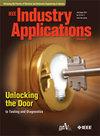海水泵系统的高效能源管理:需求优化的太阳能混合和存储
IF 4.2
2区 工程技术
Q2 ENGINEERING, ELECTRICAL & ELECTRONIC
引用次数: 0
摘要
本文研究了基于经济模型预测控制(EMPC)的需求侧管理(DSM)策略来优化海水泵系统的运行,重点是太阳能和电池储能的集成。该研究考虑了实时定价(RTP)和最大需求(MD)关税类型。提出的模型结合了水库、光伏(PV)能源和电池来执行负荷转移和管理峰值需求。分析了并网抽水系统的4种情况:随水库负荷转移;与水库和光伏能源的负荷转移;水库与储能的负荷转移;以及与水库、储能和光伏能源的负荷转移。一个大型采矿供水泵站的模拟结果表明,通过水库的负荷转移,利用太阳能来降低最大需求,以及包括电池来进一步转移负荷和增加峰值需求管理的灵活性,可以显著降低运营成本。与其他方案相比,单独使用电池进行能量存储的成本降低幅度最小。基于EMPC的DSM策略使工厂能够响应不断变化的能源价格和需求模式,从而在确保可靠运行的同时节省成本。本文章由计算机程序翻译,如有差异,请以英文原文为准。
Efficient Energy Management in Seawater Pumping Systems: Solar Hybridization and Storage for Demand Optimization
This paper investigates the use of demand-side management (DSM) strategies based on economic model predictive control (EMPC) to optimize the operation of seawater pumping systems, focusing on integrating solar energy and battery storage. The study considers both real-time pricing (RTP) and maximum demand (MD) tariff types. The proposed model combines reservoirs, photovoltaic (PV) energy source, and batteries to perform load shifting and manage peak demand. Four scenarios were analyzed for a grid connected pumping system: load shifting with reservoirs; load shifting with reservoirs and PV energy sources; load shifting with reservoirs and energy storage; and load shifting with reservoirs, energy storage, and PV energy sources. Simulation results for a large mining water supply pump station demonstrate that operational costs can be significantly reduced through load shifting with reservoirs, utilizing solar energy to lower maximum demand, and including batteries for further load shifting and increased flexibility in peak demand management. The use of batteries alone for energy storage results in the least cost reduction compared to the other scenarios. DSM strategies based on EMPC enable the plant to respond to changing energy prices and demand patterns, leading to cost savings while ensuring reliable operation.
求助全文
通过发布文献求助,成功后即可免费获取论文全文。
去求助
来源期刊

IEEE Transactions on Industry Applications
工程技术-工程:电子与电气
CiteScore
9.90
自引率
9.10%
发文量
747
审稿时长
3.3 months
期刊介绍:
The scope of the IEEE Transactions on Industry Applications includes all scope items of the IEEE Industry Applications Society, that is, the advancement of the theory and practice of electrical and electronic engineering in the development, design, manufacture, and application of electrical systems, apparatus, devices, and controls to the processes and equipment of industry and commerce; the promotion of safe, reliable, and economic installations; industry leadership in energy conservation and environmental, health, and safety issues; the creation of voluntary engineering standards and recommended practices; and the professional development of its membership.
 求助内容:
求助内容: 应助结果提醒方式:
应助结果提醒方式:


